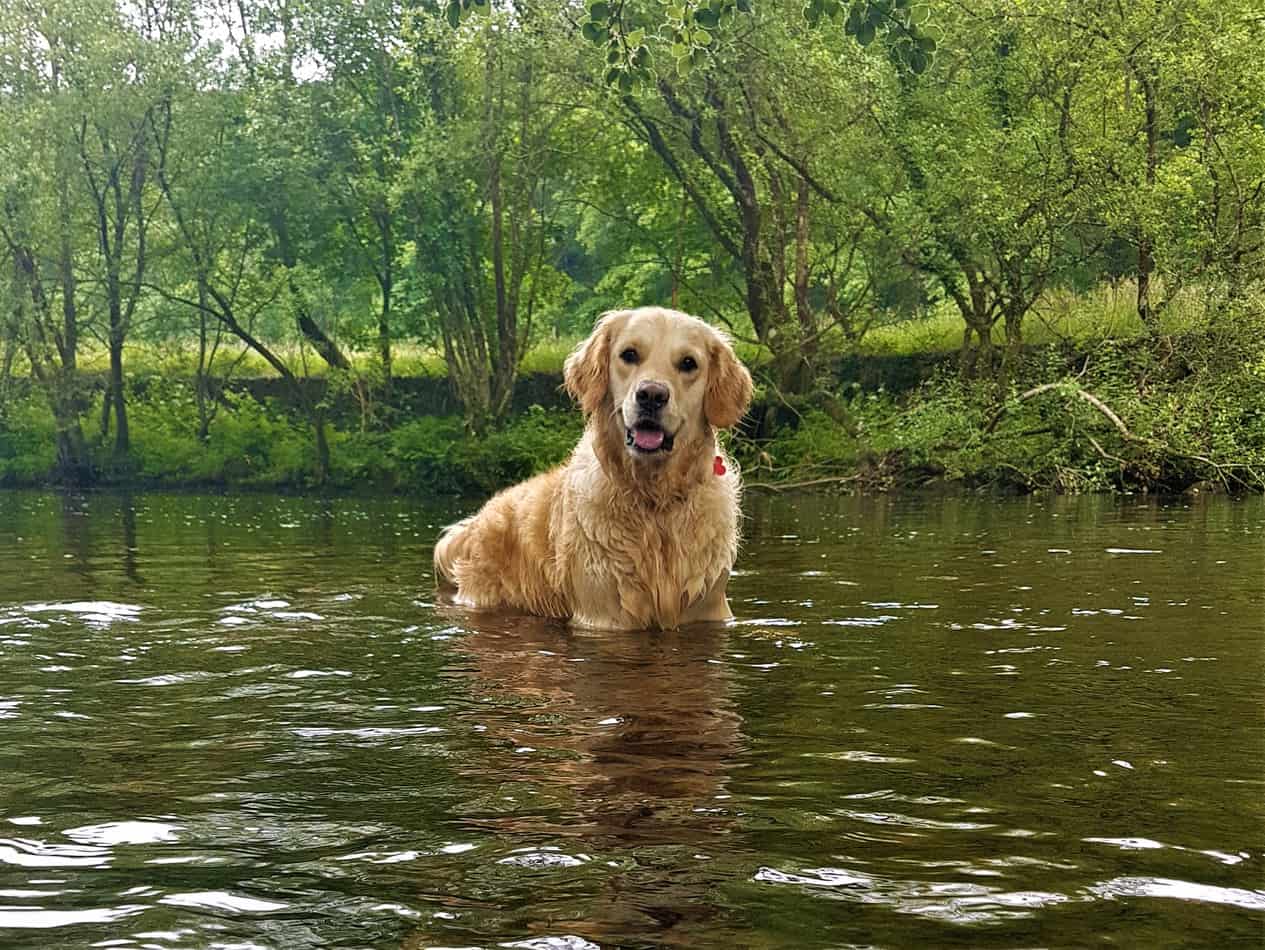Owning an energetic dog can sometimes feel like an impossible task and so finding ways to calm them down becomes more important than spending quality time with them. Walking your dog is something you should always be doing but does walking your dog make them tired.
Making your dog tired will depend on many factors and the amount of exercise they get will be one of them. Walking your dog too much will certainly make them tired but walking them enough to match their stamina will calm them down.
Although walking your dog will make them tired, many factors will determine whether your dog gets tired after a walk. The aim of walking is too really calm them down whilst giving them some good quality exercise, let’s discuss the various things that influence your dog’s energy.
Contents
Do Walks Make Dogs Tired
Dogs will get tired when their energy levels start to deplete, walking is a good form of exercise for a dog, just as it is for us. The more physical exertion a dog uses on a walk the more energy they will burn and therefore become more tired as their body attempts to conserve energy. Below are a few factors that determine the amount of energy required to make a dog tired after a walk.
Breed
This has a huge role to play in whether your dog will become tired after a walk. Different breeds are made to do different tasks and the environments in which they have been bred over many centuries will often determine their energy levels.
Working dogs tend to be the most energetic, traveling long distances on hunts or working the fields herding livestock. Border collies and springers are prime examples of energetic dogs and it is more likely that you would be tired before they are. Less energetic dog breeds would include basset hounds and toy breeds such as pugs. These breeds tend to have less energy than their working companions or a stronger desire to be lazy.
Although how a dog has been bred over the years will often determine many of their traits, lineage is not the only reason certain breeds are more energetic. For example, working breeds such as golden retrievers will have plenty of energy but will soon follow your example of sitting and relaxing when needed. Cavalier King Charles Spaniels are another good example of a dog with high energy but appears like they have low energy levels. this is mainly because Cavalier King Charles Spaniels love to cuddle up and so again like with golden retrievers they will appear calm after a walk as they love to relax with you on the sofa.
The size of a dog can also put limits on their energy levels, especially when relating to walking. If you take smaller dogs for walks you will find that they tire quicker over shorter distances than larger dogs. This is simply because they exert more energy in order to cover the same distance as you with their short legs. This is mainly true with very small toy breeds, with very short legs. Dogs such as beagles or spaniels who don’t appear to lack energy but are still fairly small, are from the working lineage and so do not tire as easily.
When choosing a breed based on their energy levels you should look closely at each breeds profile from multiple sources. By doing this you can get an understanding of the particular traits that are often mentioned.

Off Lead VS On Lead
Aside from breed, the obvious factor in making your dog tired by walking them is whether you walk them off the lead or on the lead. On lead walking can have many benefits mostly related to training, dogs that walk correctly on the lead are usually well-trained dogs. However, on lead walking doesn’t help you much when you have a very energetic working breed of dog. Although any sort of exercise is great physical and mental stimulation for your dog, you will need to walk miles before you even put a dent in a working breeds energy levels.
It’s always important to train your dog correctly from an early age and how they grow up will determine the adult they become. “Off lead” walking is going to always be the preferred source of exercise when choosing between both methods. However because you are not able to control your dog directly as you can when they are on a leash, you must ensure they are well trained with recall and other control commands. When it comes to energy levels, having your dog off the lead can do wonders for their mental stimulation and tiring them out. Dogs are meant to run free and this small amount of time they are given will be returned in a very calm, happy, and content pooch.
As mentioned before, working breeds such as printers, beagles, and retrievers will benefit the most from being let off the lead and you should endeavor to give them that chance. Smaller toys breeds won’t be as bothered but as they are still dogs they will enjoy the freedom it gives them to sniff everything and run around. Be sure to keep an eye on smaller breeds as they will tire quickly if they run around too much. Puppies should also be carefully watched as too much exercise can damage their joints, this is because they are fusing together. For more information on how much exercise a puppy should be getting check out, our article “How Much Exercise Does a Dog Need Everyday”
Age
The age of your dog will always be a factor in determining whether your walking schedule will tire them out. Puppies will tend to not realize how much exercise they are having until they suddenly burn out. It’s important not to let this happen as mentioned above, puppies joints are still fusing together and overwalking can be damaging to them. As your dog grows they will learn the limitations of their own energy and slow down when needed. However given a full tank of energy they will give any puppy a run for their money, it’s still important to not let them overdo it but its OK if they end up tiring themselves out. Older dogs will simply go the speed they are comfortable with and sometimes you will be the one waiting for them. Just because your older dog is walking slowly doesn’t be they don’t enjoy their walks. Dogs will always enjoy walking whatever age they are, they are just more likely to sleep when you get home.
Is Walking Your Dog Enough Exercise
As we have learned above the term “Enough Exercise” depends on many factors, including breed, age, and type of walk. You will often find that dogs become restless when they haven’t been for their daily walk, this is due to built up energy and lack of mental stimulation, it is also part of their routine so they expect it.
How Much Exercise Is Enough For a Dog?
A general rule of thumb for the amount of exercise to give a dog is at least 30 minutes, from my own personnel experiences walking my golden retriever on the lead will only be beneficial after 30 minutes, otherwise, he is thoroughly stubborn on our return home. I would recommend two 30 minute walks if you are strapped for time one in the morning and one in the evening. However for working breeds the most ideal walking time would be around 1 hour, especially if they are on the lead the whole way. If you intend to walk them off the lead or have part of your walking route as a free run, 30 minutes may be sufficient enough.
Smaller toy breeds require much less exercise than working breeds and so 30 minutes will probably suffice for a walk. Although they require less exercise I would still recommend taking them out twice a day as it will be beneficial to their mental stimulation.
As with all breeds, walking your dog off the lead will most likely give them the exercise they need. However, if you are unable to walk your dog due to the weather or other commitments, then spend some time playing indoors, throwing a ball around or tug of war are all good ways to mentally stimulate your dog. Even if you only have time for a 15-minute block walk, this is so much better than leaving them to their own devices all day. Interaction is key for a dog and just letting them outside won’t suffice they need that interaction with others.
Why Is It Important To Walk Your Dog
There are many benefits to walking your dog and the importance of this comes in a few different forms which we will discuss below.
Physical Exertion
The most obvious one relates to energy levels and the general physicality of your dog. Dogs that don’t get walked will become physically unfit and will struggle with health issues in the future. Just like their owners trying to go running in the new year, a dog will feel that struggle for comfortable exercise. Sometimes people see dogs as animals that are always able to run long distances and keep up with the demand put on them, but this is not true. The amount of physical exercise a dog can comfortably take can highly depend on how fit they are. You may be thinking that you don’t want an ultra-fit dog as that means more walking for you, well it doesn’t work like that. Dogs need exercise and the fitter your dog is the happier they are going to be, a content dog in most cases means a calm dog. For more information on which breeds are considered high energy and which are considered low energy, “Dogtime” has a great article that identifies specific breeds of dog with high or low energy.
Mental Stimulation
Many owners think that a dog’s walk is purely for exercise and energy loss, well this is not true. One of the most important parts of taking your dog for a walk is the opportunity to give them the mental stimulation they cannot get inside. Interacting with nature is something dogs are made to do, whether its visual, scent, or touch your dog needs variety in their lives. Ye sure sniffing the same fenced off garden every day has to be done, but there is so much more for your dog to enjoy out and about in the great wide world.
If you were to drive your dog somewhere you always go and let them sniff around, you may find them looking upon at you wondering when the walk is going to start. Compare this with driving somewhere completely new and letting your dog explore on their own. I can imagine in most cases you will find your dog is content a lot longer in the brand new place than the one they know. My point is dogs love to discover and it is probably one of the most mentally stimulating activities you can do with your dog. Mental stimulation can calm your dog down and even true them out, producing a truly content dog.
If you want to give your dog more mental stimulation than they are currently getting try taking them on a scent walk. This type of walk is more of a psychology than a set of rules, changing the mindset of you the owner. A scent walk is about allowing your dog to sniff, let it happen, and go where they go. If your dog wants to sniff something for 5 minutes you let them. If you can’t get out for whatever reason try hiding some treats around the house or garden and just allowing your dog to find them. Scavenging comes naturally to dogs, which is the unfortunate reason why they stare at you whilst you cook your own dinner. For an interesting article on the smells dogs love check out our article on “13 smells dogs cant resist”.
Is a Dog Swimming Equivalent To Walking
If your dog is an effective swimmer then you should encourage this form of exercise as much as possible. Although swimming and walking cannot be regarded as similar exercises for obvious reasons, swimming does hold some benefits that walking does not and is most likely to burn more energy.
Some of the main benefits of a dog swimming can be:
- Less impact on joints – Dogs can have many problems with their joints, due to either over-exercising at an early age or genetics. Swimming can help to slow the deterioration of your dog’s joints, although this still depends on how they act on land.
- High energy Burn – Swimming is just as good as walking if not better. The amount of energy a dog will burn when swimming can easily beat a standard walk.
- Mental Stimulation – Dogs love routine but they also enjoy something different. Allowing them to experience both the land and the water can be great for them mentally.
You can easily incorporate swimming into your walking routine by finding somewhere nearby with a water source such as a river, lake, or beach. Both allowing your dog to run off the lead and swim will almost certainly tire any dog out. You might be interested in our article “What age to teach your puppy to swim”

Why Is My Dog So Tired After a Walk
As this article discusses the many ways in which a dog can become tired through walking, we should also highlight some things to look out for if exercise is not the cause of your dog’s energy loss. It’s important to visit your vet if you believe your dog is becoming tired too easily and it’s not one of the above reasons. It’s not always something majorly serious but its best to get expert advice rather than randomly guess at things. Certain things you can look at would be their diet, mood, and whether they fear the area your walking them. These examples could cause your dog to be low on energy or appear less active during their walk. For some extra information on your dog’s lethargy, here’s a great article from “vets now” which offers some advice.
Can You Over Walk a Dog
The answer to this is yes, you can over walk a dog, and in many ways, you should try to avoid this. The idea of tiring your dog out by walking them is not to have them sleeping in for the next 2 days but to keep them calm and content. Over walking any dog can have negative impacts on their joints, you should be especially aware of puppies and older dogs, when deciding to take them on long active walks. Always remember that regular walking can help more than over walking, as a happy content dog will be getting lots of mental stimulation from their daily walks.
Conclusion
By now you realize the factors that influence how tired your dog can get during a walk. If you do have a more energetic dog I would encourage finding somewhere you can let them run off lead and even incorporate come swimming in your walk. Even if your dog’s energy levels are still too much for even this type of walk, they should at the very least be much calmer and content at home. The last note to leave you with is, try to remember that mental stimulation is just as important, if not more important than rigorous exercise. If you enjoyed this article don’t forget to have a look at our homepage where you will find even more great content on walking your dog and getting outside with them.

